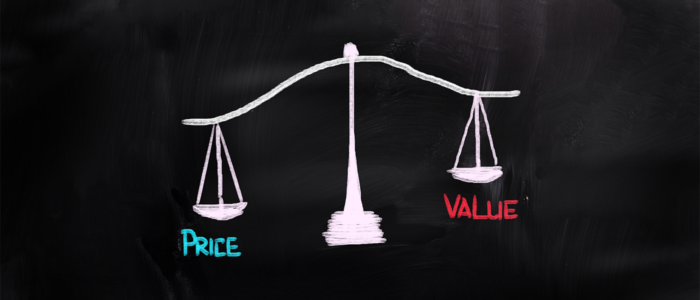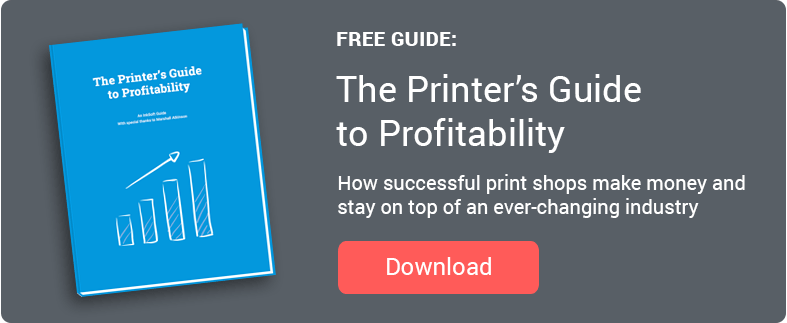You’ve been running your print shop for a while, but that nagging thought keeps creeping up: How does your pricing measure up to your competitors’? That guy down the street is charging a few bucks more, but the other one is charging a few less. Will your pricing attract or push away potential customers?
Pricing is without a doubt one of the biggest points of confusion new business owners (printers or otherwise) contend with. So today we’re going to break down the basics of pricing psychology and how to land higher-priced orders in your print shop.
How low should you go?
When you find out that you’re losing customers on price, it can be tempting to lower your prices. The lower profit per sale should be balanced out with an increase in customers, right? Unfortunately, this isn’t really the case long-term, because buyers aren’t only concerned with cost.
Here’s what actually happens: When you charge lower prices, you naturally need to make some sacrifices. Lower prices mean maybe you buy lower quality blanks, or you cut production hours, or you pass up on employee pizza days or attending trade shows. “It’s just until sales pick up,” you tell yourself, but that initial boost in sales dies quickly once customers notice how stiff the shirts are, the bleeding ink, and your disgruntled employees. Plus, let’s be honest””any customer who’s looking for only the cheapest option probably won’t be the kind of customer who returns for more.
Competing on price alone is risky at best, and more often a race to the bottom. The reality, then, is you must find a way to charge mid-level to higher-end prices while attracting customers who are willing to pay them.
How to command higher prices
So if you shouldn’t lower your prices, how do you keep customers coming in your door (or website)?
The secret is accepting that you can’t be everything to everyone. Here’s what I mean:
Think of the last restaurant you went to. Why did you go? Maybe it was nearby, or it was cheap, or it had the best quality food, or the staff was the most efficient. But chances are it didn’t have all of those attributes. If you wanted a quick bite, fast food did the job””it wasn’t the best quality, but that’s not what you were after anyway. Or if you went to have a steak dinner, you were willing to accept the fact that you’d be paying more for the higher quality of food.
Businesses don’t need to compete on every aspect. In fact, it’s impossible to be the best in all areas. The most successful businesses figure out what sets them apart and who their ideal buyers are. Then, they go all-in.
Your businesses won’t appeal to every person on the street, but you know what? That’s perfectly okay. The buyers who you do appeal to will feel like you’re a perfect match for their needs””and you can bet they’ll keep returning for more.
Finding what sets your business apart
If you find that you’re losing customers on price, it’s time to beef up your strong points in other areas. Make your business stand out in something else. Practically, this might look like:
- Increasing the quality of your garments to make it worth the higher price
- Investing in a DTG printer or heat press and offering small orders of t-shirts
- Increasing your range of products to become a one-stop shop
- Offering fundraising stores
- Creating a dedicated sales/client management team for more polished customer interactions
- Specializing in a niche market
- Starting a “t-shirt of the month” subscription program
Make it your job to continuously find new ways to specialize your business. It’s not an easy task, but the bottomline is that specialized businesses are able to charge higher prices than the generalists.
Communicating the difference
Once you have a differentiator, it’s time to put it to work. In marketing, this is called “positioning.” You have to showcase that new specialty, or else customers won’t understand why your products are worth the higher price. The moment a customer understands the value of your business and product is the moment they’ll accept a higher price.
There are endless ways to strengthen your position through marketing, but here are a few ideas to get you started:
- Drive it home anytime there’s an opportunity on your website or marketing channels: “Our friendly team members will help you set up the perfect fundraising store!”
- Consider incorporating your focus in a values statement on your website’s About page.
- Add customer testimonials to your website and social media that highlight your focus area.
- Run a promotion that showcases your focus area, such as a big push on fundraising stores or a special package for members of your niche market.
Want more pricing advice?
We cover this topic and so much more in our free e-book!




Thank you for that uplifting article – Our main business is embroidery, but offer heat press garments also. It has always been a hard area to compete. Reading your wonderful article inspired me to address the areas we have trouble with and it gives me new hope that we can bring new customers on board with your great ideas. Anne-Marie
I’m so glad it’s helpful, Anne-Marie! Thank you for commenting.